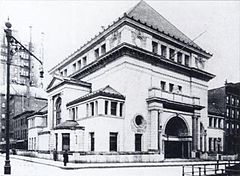Brooklyn Savings Bank (building)
| Brooklyn Savings Bank | |
|---|---|

Brooklyn Savings Bank, photographed c. 1905-07
|
|
| General information | |
| Type | Bank |
| Architectural style | Neoclassical/Italian Renaissance |
| Location | Cnr. Clinton and Pierrepont Sts., Brooklyn Heights, New York |
| Construction started | 1892 |
| Completed | 1894 |
| Demolished | February 1964 |
| Cost | $300,000 |
| Height | 80 ft; 75 ft to ceiling |
| Dimensions | |
| Other dimensions | 95 × 115 ft |
| Design and construction | |
| Architect | Frank Freeman |
The Brooklyn Savings Bank was a notable building in Brooklyn, New York, designed by prominent Brooklyn architect Frank Freeman. Completed in 1894, it was considered one of Freeman's finest works, but in spite of its widely recognized architectural significance, the building was demolished in 1964, shortly before the designation of the neighborhood as a historic district.
The Brooklyn Savings Bank was established as an institution in 1827. It originally operated from the basement of the Apprentices' Library Building at the corner of Cranberry and Henry Streets, Brooklyn. In 1847, the Bank moved to new premises at the juncture of Fulton, Concord and Liberty Streets. After the opening of the Brooklyn Bridge in 1883 however, the city fathers decided to build a "grand avenue" leading to the approach of the bridge, and as the resulting plans entailed demolition of part of the Brooklyn Savings Bank in Liberty Street, the Bank's directors resolved to move to a new location.
The location chosen by the directors as the most appropriate for their new premises was the northeast corner of Clinton and Pierrepont Streets, Brooklyn, then occupied by the First Baptist Church. Though initially reluctant to move, the parishioners were eventually persuaded by an offer of $200,000, and the church was subsequently demolished to make way for the new bank. Noted Brooklyn architect Frank Freeman was commissioned to design the $300,000 building. Construction began in 1892 and was completed in 1894.
The building was to remain the Brooklyn Savings Bank's headquarters for almost 70 years. In 1961, the bank's management decided to build a new headquarters at the corner of Montague and Fulton Streets, Brooklyn, and in 1963 the old bank building was sold to the Franklin National Bank, after which it lay idle for some months. In late 1963, Franklin National announced plans to sell the property to developers for commercial redevelopment. In spite of last-ditch attempts by the community to save the historic building, it went under the wrecker's hammer in early 1964.
Loss of the bank, along with several other historic buildings around this time, prompted the city government to move to protect other buildings in the locality, and in November 1965, the area was formally designated an historic district. Today, the former site of the bank is occupied by One Plaza Place, a combined office and residential highrise.
At the time Freeman designed the bank, he had already acquired a reputation as a leading exponent of the Richardsonian Romanesque style. In 1893 however, the World's Columbian Exposition in Chicago was held, which showcased the neoclassical style. Like many other American architects of the day, Freeman was quick to adapt, and the Brooklyn Savings Bank would become one of his first neoclassical designs. In spite of his relative inexperience with the style, the bank has been cited as perhaps Freeman's finest work.
...
Wikipedia
